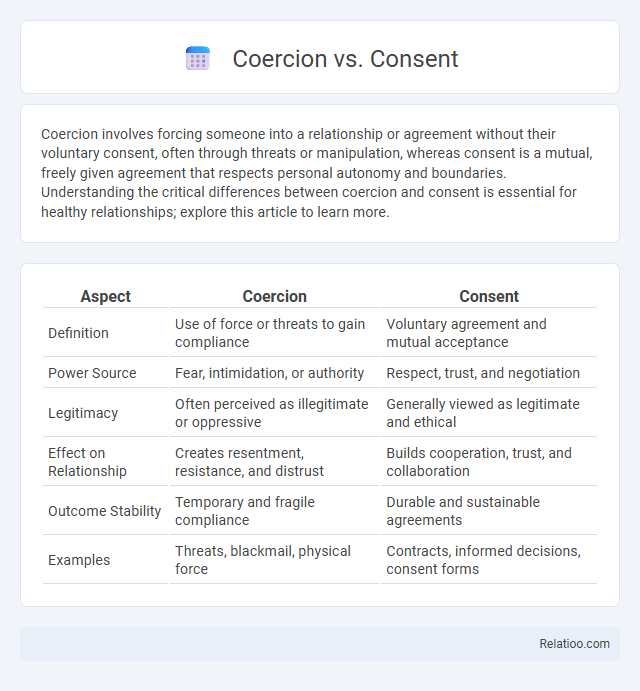Coercion involves forcing someone into a relationship or agreement without their voluntary consent, often through threats or manipulation, whereas consent is a mutual, freely given agreement that respects personal autonomy and boundaries. Understanding the critical differences between coercion and consent is essential for healthy relationships; explore this article to learn more.
Table of Comparison
| Aspect | Coercion | Consent |
|---|---|---|
| Definition | Use of force or threats to gain compliance | Voluntary agreement and mutual acceptance |
| Power Source | Fear, intimidation, or authority | Respect, trust, and negotiation |
| Legitimacy | Often perceived as illegitimate or oppressive | Generally viewed as legitimate and ethical |
| Effect on Relationship | Creates resentment, resistance, and distrust | Builds cooperation, trust, and collaboration |
| Outcome Stability | Temporary and fragile compliance | Durable and sustainable agreements |
| Examples | Threats, blackmail, physical force | Contracts, informed decisions, consent forms |
Understanding Coercion and Consent
Coercion involves forcing someone to act against their will through threats, intimidation, or manipulation, undermining genuine autonomy. Consent requires clear, informed, and voluntary agreement to an action, reflecting true personal choice without pressure or deceit. Understanding the distinction between coercion and consent is crucial for ethical interactions, ensuring respect for individual rights and freedom.
Defining Key Terms: What is Coercion? What is Consent?
Coercion involves compelling someone to act against their will through force, threats, or intimidation, undermining true autonomy and free choice. Consent is the voluntary, informed, and enthusiastic agreement to an action or decision, reflecting genuine willingness without pressure or manipulation. Understanding the difference between coercion and consent is crucial for Your interactions, ensuring respect for individual rights and ethical boundaries.
Historical Perspectives on Coercion and Consent
Historical perspectives on coercion reveal its use as a tool for maintaining power through force and intimidation, often undermining genuine consent. Consent has evolved as a fundamental principle in social contracts, emphasizing voluntary agreement and mutual respect, contrasting sharply with the oppressive nature of coercion. Your understanding of these concepts highlights how societies have struggled to balance authority and individual autonomy throughout history.
Psychological Impact of Coercion vs Consent
Psychological impact of coercion often leads to increased stress, anxiety, and feelings of helplessness due to the lack of autonomy and perceived threat. In contrast, consent promotes psychological well-being by fostering trust, respect, and a sense of control, which enhances emotional resilience. Repression, unlike both, suppresses genuine emotions and thoughts, potentially causing long-term psychological harm through unresolved conflicts and reduced self-awareness.
Power Dynamics in Coercion and Consent
Power dynamics in coercion involve the use of authority or force to compel compliance, often limiting the autonomy and free will of the individual subjected to it. In contrast, consent arises from a voluntary agreement where power is balanced or negotiated, allowing all parties to retain agency and decision-making capacity. Understanding these differences is crucial in distinguishing between oppressive control and legitimate, consensual interactions within social, legal, and political contexts.
Legal Framework: Coercion vs Consent
The legal framework distinguishes coercion from consent by defining consent as a voluntary and informed agreement without threats or undue pressure, while coercion involves force, intimidation, or manipulation undermining free will. Your rights are protected under laws that invalidate agreements obtained through coercion, ensuring that any contract or agreement must be entered into freely to be legally enforceable. Courts examine the presence of coercive elements to determine the legitimacy and binding nature of consent in legal disputes.
Real-life Examples: Identifying Coercion and Consent
Understanding the difference between coercion and consent is vital in real-life situations such as workplace agreements, medical decisions, and personal relationships. Coercion involves pressure or threats that undermine your free will, while genuine consent arises from clear, voluntary agreement without manipulation. Identifying coercion requires recognizing signs like intimidation or lack of choice, ensuring your decisions reflect true autonomy rather than repression or force.
Social and Cultural Influences
Social and cultural influences shape coercion, consent, and repression by defining acceptable behaviors and power dynamics within a community. Cultural norms and social institutions often determine the boundaries between voluntary consent and coercive pressure, reinforcing or challenging repressive systems. Factors such as tradition, social hierarchy, and collective values heavily impact individual autonomy and the legitimacy of consent in various social contexts.
The Role of Communication in Establishing Consent
Effective communication plays a crucial role in establishing genuine consent by ensuring all parties clearly understand intentions, boundaries, and mutual agreement. Through transparent dialogue, risks of coercion and misunderstanding are minimized, fostering trust and respect. Consent is valid only when communication is open, voluntary, and informed, differentiating it sharply from repression or coercion where power imbalances hinder free expression.
Promoting a Culture of Consent
Promoting a culture of consent involves emphasizing mutual agreement and clear communication in all interactions to prevent coercion and repression. Your commitment to respecting boundaries and seeking explicit permission fosters trust and empowers individuals to assert their autonomy. Understanding the distinction between coercion, where force or pressure undermines free choice, and consent, which is freely given, is essential in creating safe and inclusive environments.

Infographic: Coercion vs Consent
 relatioo.com
relatioo.com